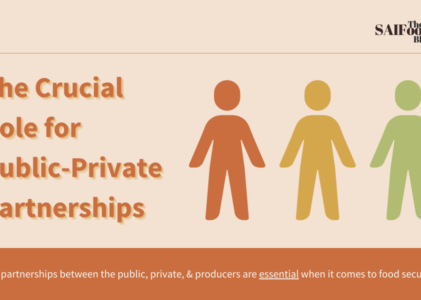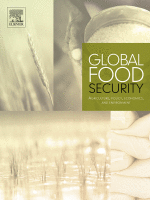P3s are major contributors to improved food security
For the first part of the millennium, the global number of food insecure individuals fell significantly between 2005 and 2014, from 825 million to 629 million. Regrettably, from 2015 onward, the number of food insecure has once again increased, rising to 688 million in 2019. As part of the efforts to improve food security, the Food and Agriculture Organization (FAO) has encouraged greater investments in agricultural productivity. As part of these efforts, the FAO partnered with CropLife International in 2020 to work together to accelerate technological applications targeted at improving global food security and advancing rural development. This initiative followed numerous others made by international institutions holding similar objectives. However, within weeks of this announcement, hundreds of activist organizations began to publicly criticize this partnership. This is both perplexing and concerning.
Declining public R&D funding
For decades, the agriculture industry has been successful at ensuring that crop yields increase without having to create more farmland to produce crops. Since 1960, global crop production has increased four-fold, while the amount of land used to produce crops has increased by 10%. Investments over the past 60 years have been tremendously successful at raising yields, as well as improving crop capabilities of withstanding insect and disease pressures. However, public sector funding for this research has been declining in recent years. These declines have partially been offset with private sector funding rising from US$5 billion in 1990 to over US$15 billion in 2014. Given this trend, agriculture is increasingly witnessing the utilization of public-private partnerships (P3s) to increase food security related research.
Value of P3s for research collaborations
While the P3 concept can cover a wide variety of interactions, in agricultural applications, they most typically involve either government-industry or university-industry arrangements. These collaborations commonly involve long-term commitments ranging anywhere from 5-30 years. The objective of P3s is to share risks, costs and resources in pursuit of their shared goals. In agriculture, the shared goal is the improved development of crop varieties that contribute to improved food security.
A primary P3 driver is when the partners have shared objectives that align with each partners’ strategic mission; with each partner bringing a critical part of the project that, only together, can any of the partners realize the outcomes. When P3s are created within the agricultural sector, they lower new technology development costs and improve the technology transfer processes, getting the innovative products into the hands of farmers more rapidly than would have been the case if the P3 hadn’t existed. Without the contributions from P3s, R&D would be isolated, scaled back efforts that require greater amounts of funding and time, to release new products.
P3s contributions have improved food security
There are numerous historical examples regarding how the development of international research centers have advanced plant breeding and food security. One of the earliest examples began in 1943 when the Rockefeller Foundation partnered with the government of Mexico to create the International Agriculture Program, led by Normal Borlaug, to improve yields of beans, corn, wheat and potatoes. In 1960, the Ford and Rockefeller Foundations collaborated with the government of the Philippines to create the International Rice Research Institute (IRRI). Together, these two centers introduced higher-yielding, semi-dwarf wheat and rice varieties that drove the Green Revolution, during which perennial food-insecure countries such as Mexico and India gained basic self-sufficiency. These efforts have since expanded. The Consultative Group for International Agricultural Research (CGIAR) is the coordinating mechanism for this effort, managing 15 Centers with research programs on five continents and formal funding arrangements with 57 national governments, 12 international development agencies (such as the African Development Bank and the United Nations Development Programme) and four global foundations (Ford, Kellogg, Syngenta and the Bill and Melinda Gates Foundations).
One notable example from the African continent is the Water Efficient Maize for Africa (WEMA) partnership. This P3 was launched in March 2008 to help farmers manage risks of drought by developing and deploying maize varieties yielding 24-35% more under moderate drought conditions, than previous varieties. Together Monsanto, the Bill and Melinda Gates Foundation, the Howard G. Buffett Foundation, the African Agricultural Technology Foundation (itself a partnership of PepsiCo and several other foundations) and the United States Agency for International Development, partnered with CIMMYT for more than a decade on the WEMA venture.
The International Fund for Agricultural Development (IFAD), was established in 1978 to increase food security, reduce poverty and support rural development in rural areas of developing countries. IFAD has aggressively adopted a P4 (public-private-producer partnership) model to work with mostly small- or medium-sized locally-situated firms to drive research and innovation. Like IFAD, the CGIAR announced there would be a significant role for the use of both P3s and P4s in its new 2030 research and innovation strategy.
Activist misinformation
Improving global food security will require increased R&D investments. As the past decade has indicated funding this innovation will increasingly require the collaboration of public and private funders. Without these collaborations, the number of food insecure would be expected to rise over the coming decade. The benefits of past P3s, both in terms of improved food security and rural development, confirm the crucial contributions. Regrettably, many activist organizations ignore the food security and rural development improvements, relying instead on the outdated political ideology that is critical of all partnerships between the public and private sectors. However, these activist organizations fail to offer viable solutions capable of improving food security and rural development. As is far too often the case, activists use politics to reject innovative, beneficial technologies and products as the evidence of success conflicts with the propaganda their organization focuses on disseminating. One of the most significant barriers to improved global food security is activist misinformation.
P3s have improved, and are improving, food security. The evidence overwhelmingly concludes this. Opposition to P3s from activist organizations is entirely political. Efforts to improve food security require investments into technologies that will increase yields, but also requires investments to refute activist propaganda against the beneficial contribution of P3s. For these activist organizations, their objectives are to raise money and issue calls to ban or prevent efforts to improve food security, and it is these actions that should be subjected to rigorous questioning. But instead of questioning the motives of these activists which are holding back food security, we continue to see the partnerships between public and private be questioned and judged. Calls for bans by well-fed activists in food secure countries are unethical. Food security can be improved, but the political battle will be as great as the technological battle.
The full article can be found in the December 2021 volume of Global Food Security:
Smyth, S. J., Webb, S. R., & Phillips, P. W. (2021). The role of public-private partnerships in improving global food security. Global Food Security, 31, 100588. doi:10.1016/j.gfs.2021.100588



